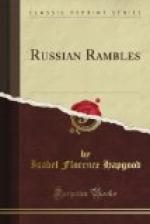We began to think that we understood our Moscow friend’s enigmatic smile, and to regret that we had not met him and his wife at the Fair, as we had originally arranged to do.
The far-famed Fair of Nizhni Novgorod—“Makary,” the Russians call it, from the town and monastery of St. Makary, sixty miles farther down the Volga, where it was held from 1624 until the present location was adopted in 1824—was a disappointment to us. There is no denying that. Until railways and steamers were introduced into these parts, and facilitated the distribution of goods, and of commonplaceness and monotony, it probably merited all the extravagant praises of its picturesqueness and variety which have been lavished upon it. The traveler arrives there with indefinite but vast expectations. A fancy dress ball on an enormous scale, combined with an International Exposition, would seem to be the nearest approach possible to a description of his confused anticipations. That is, in a measure, what one sees; and, on the other hand, it is exactly the reverse of what he sees. I must confess that I think our disappointment was partly our own fault. Had we, like most travelers who have written extravagantly about the Fair, come to it fresh from a stay of (at most) three weeks in St. Petersburg and Moscow only, we should have been much impressed by the variety of types and goods, I have no doubt. But we had spent nearly two years in the land, and were familiar with the types and goods of the capitals and of other places, so that there was little that was new to us. Consequently, though we found the Fair very interesting, we were not able to excite ourselves to any extravagant degree of amazement or rapture.
The Fair proper consists of a mass of two-story “stone” (brick and cement) buildings, inclosed on three sides by a canal in the shape of a horseshoe. Through the centre runs a broad boulevard planted with trees, ending at the open point of the horseshoe in the residence occupied by the governor during the Fair (he usually lives in the Kremlin of the Upper Town), the post-office, and other public buildings. Across the other end of the boulevard and “rows” of the Gostinny Dvor, with their arcades full of benches occupied by fat merchants or indolent visitors, and serving as a chord to the arc of the horseshoe, run the “Chinese rows,” which derive their name from the style of their curving iron roofs and their ornaments, not from the nationality of the merchants, or of the goods sold there. It is, probably, a mere accident that the wholesale shops for overland tea are situated in the Chinese rows. It is a good place to see the great bales of “Kiakhta tea,” still in their wrappings of rawhides, with the hair inside and the hieroglyphical addresses, weights, and so forth, cut into the skins, instead of being painted on them, just as they have been brought overland from Kiakhta on the Chinese border of Siberia. Here, also, rises the great Makary Cathedral, which




